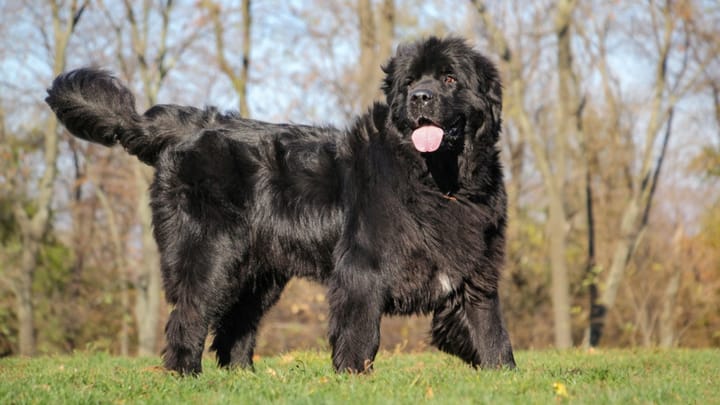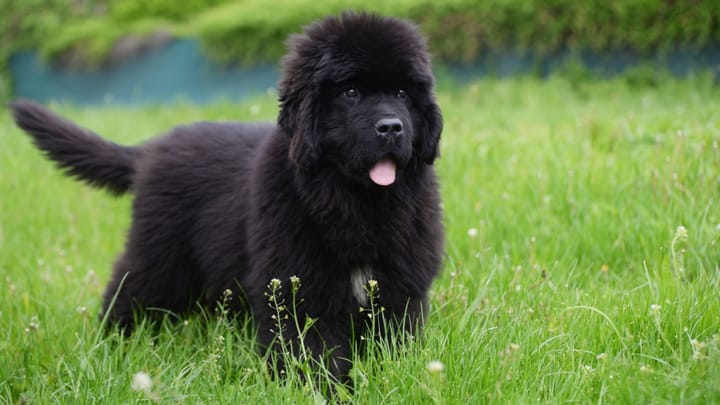Newfoundland
Other name: Newfie


The Newfoundland dog is a large, gentle breed known for its affectionate and loyal nature. Calm, sociable, and eager to please, it makes a devoted family companion. Often called “Newfies,” these intelligent dogs are easy to train and adapt well to home life. They’re also renowned for their bravery in water rescue, guided by a strong instinct to help and protect.
|
Life expectancy |
The Newfoundland has a life expectancy of between 10 and 12 years |
|
Temperament |
|
|
Size |
Large
|
|
Adult size |
Female
Between 25 and 27 in
Male
Between 27 and 29 in
|
|
Adult weight |
Female
Between 110 and 132 lb
Male
Between 132 and 154 lb
|
|
Coat colour
There are three different standards for this breed: those of the FCI, the US and Canada. Between these, it’s mainly the coat colour that changes. Therefore, depending on the variety, the coat can be black, brown, or Landseer (white and black). |
Black White Brown |
|
Type of coat
The coat is medium-length. The fur is flat, dense, thick and slightly oily, which makes it completely waterproof. |
Long |
|
Eye colour
The eyes are dark brown for individuals with black and white coats. For those with brown coats, the official standards accept lighter eyes. |
Brown
|
|
Purchase price |
The Newfoundland costs between £890 and £1190 |
The Newfoundland dog is an outstanding swimmer with a deep love for water. Renowned for its lifesaving abilities, it has rightfully earned the nickname "St. Bernard of the seas." Thanks to their strength, courage, and devotion to others, Newfoundlands excel in water rescue. Their webbed feet and waterproof double coat offer exceptional protection against cold and damp conditions, making them uniquely equipped for this role. This impressive breed is often confused with the Landseer, its closest relative. However, they are recognised as distinct breeds. The Landseer tends to be taller and leaner, with a distinctive white marking on the head that distinguishes it.
More details about the Newfoundland
Newfoundland: Origins and history
There are two primary theories regarding the origin of the Newfoundland dog. One suggests it descended from large dogs brought to North America by the Vikings. Another links its ancestry to the Tibetan Mastiff, brought over by early Indigenous peoples via the Bering Strait. These “big black dogs,” used for hunting, fishing, guarding, and sledge-pulling, were described in Professor Otis Mason’s American Indian Handbook. It’s likely that the modern Newfoundland resulted from a mix of Viking and Indigenous dogs.
Physical characteristics of the Newfoundland
This is an impressive dog, particularly noted for its physical strength and active nature. Although powerfully built, it doesn’t appear intimidating. The head is large with a gentle stop, and the muzzle is short, square, and covered in fine, short hair. The skull is broad, with parallel axes, while the eyes are small, deep-set, and typically brown, giving a calm and thoughtful expression. The ears are small, set well back on the head, and hang down to frame the face. The body is solid and well-proportioned, supported by strong, muscular limbs. The medium-length tail reaches just below the hocks, usually carried low when the dog is at rest, and raised slightly when in motion.
Newfoundland: Characteristics
Newfoundland: Behaviour
Training a Newfoundland
Newfoundland dogs are intelligent and eager to please, making them a pleasure to train. They respond well to clear, consistent guidance, though early training is important due to their size and strength. Positive reinforcement is essential, as harsh methods can upset this gentle, sensitive breed. With patience and kindness, they grow into loyal, well-behaved companions.
Newfoundland: Lifestyle
Breed compatibility Newfoundland
Newfoundland: Purchase price
The cost of a Newfoundland dog can vary depending on its breeding and pedigree, but you should expect to pay around £1,185 for a Kennel Club-registered puppy.
Ongoing care for this large breed can also add up. With their substantial appetite and regular grooming requirements, monthly expenses can reach £80 or more, so it’s important to budget accordingly before bringing one home.
Newfoundland: Shedding
Average
The Newfie’s amount of hair loss is particularly high during the annual shedding periods, in spring and autumn.
Newfoundland: Grooming
The grooming needs of a Newfoundland's medium-length coat can be demanding, particularly as they tend to shed heavily. Brushing several times a week is often necessary to manage moulting and keep the coat in good condition. After swimming or getting wet, it’s important to rinse and thoroughly dry the coat, a process that can take time due to the dog’s thick fur. However, avoid using shampoo, as this can strip the coat of its natural oils and compromise its water-resistant properties. Extra care should also be taken with the ears, especially for dogs that swim regularly, to help prevent moisture-related issues such as infections.
Newfoundland: Health
The average lifespan of a Newfoundland dog is around 11 years.
This is undoubtedly a robust breed, aside from a few more delicate months during puppyhood. Once matured, the Newfoundland generally enjoys good health and has a relatively long life expectancy for a dog of its size.
Thanks to their thick fur, Newfoundlands can be prone to overheating. It’s important to avoid leaving them in direct sunlight for extended periods, particularly during the summer months.
The Newfoundland’s double coat makes it exceptionally well-suited to cold and damp conditions. Its thick, oily fur provides insulation and water resistance, allowing it to swim in freezing temperatures without becoming chilled.
If their diet matches their physical needs, they aren't overfed, and they receive regular exercise, Newfoundlands are unlikely to become overweight. Despite their size, these sensitive dogs can maintain a healthy weight with the right care and lifestyle.
Common health issues in Newfoundland dogs include:
- Hip and elbow dysplasia - abnormal joint development leading to discomfort and mobility issues
- Overheating – due to their thick coat, especially in warm weather
- Chondrodysplasia – a disorder affecting cartilage development
- Neoplasia – abnormal tissue growth, which may be benign or malignant
- Myasthenia gravis – a chronic neuromuscular condition causing muscle weakness
- Cataracts – clouding of the eye’s lens, affecting vision
- Ectropion/entropion – eyelid disorders where the lid turns outward or inward
- Cystinuria – a genetic condition leading to the formation of kidney or bladder stones
- Primary ciliary dyskinesia – a respiratory disease affecting the movement of cilia in the airways
Regular vet check-ups and responsible breeding can help manage and reduce the risk of many of these conditions





